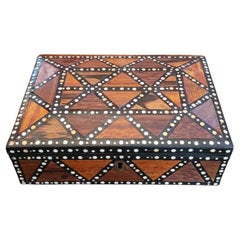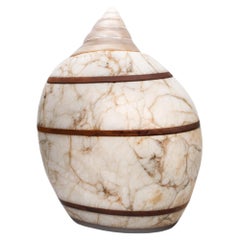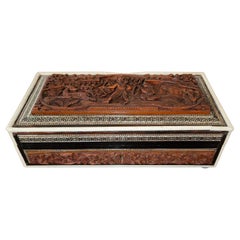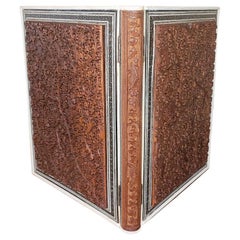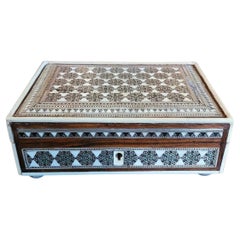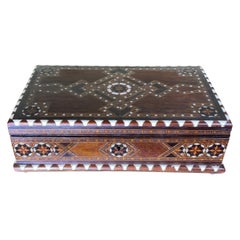Sandalwood Boxes
19th Century Sri Lankan Anglo-Indian Antique Sandalwood Boxes
Bone, Hardwood, Ebony, Sandalwood
1980s American Mid-Century Modern Vintage Sandalwood Boxes
Marble
Late 19th Century Indian Anglo-Indian Antique Sandalwood Boxes
Silver, Pewter
Late 19th Century Indian Anglo Raj Antique Sandalwood Boxes
Bone, Precious Stone, Sandalwood
Late 19th Century Indian Anglo-Indian Antique Sandalwood Boxes
Silver
Late 19th Century Indian Anglo-Indian Antique Sandalwood Boxes
Bone, Padouk, Sandalwood
Late 19th Century Indian Anglo-Indian Antique Sandalwood Boxes
Bone, Padouk, Sandalwood
19th Century Indian Anglo-Indian Antique Sandalwood Boxes
Bone, Shell, Sandalwood
19th Century Indian Anglo-Indian Antique Sandalwood Boxes
Bone, Padouk, Sandalwood
19th Century Indian Anglo-Indian Antique Sandalwood Boxes
Silver
Late 18th Century Indian Anglo-Indian Antique Sandalwood Boxes
Brass
18th Century Indian Anglo-Indian Antique Sandalwood Boxes
Multi-gemstone, Brass
Early 20th Century French Art Deco Sandalwood Boxes
Chrome
Early 19th Century Sri Lankan Anglo-Indian Antique Sandalwood Boxes
Bone, Ebony, Sandalwood
Late 19th Century Indian Antique Sandalwood Boxes
Sandalwood
Early 19th Century Indian Regency Antique Sandalwood Boxes
Bone, Sandalwood, Ivory
Late 19th Century Indian Anglo-Indian Antique Sandalwood Boxes
Sandalwood
Late 19th Century Indian Anglo Raj Antique Sandalwood Boxes
Sandalwood
Early 20th Century Indian Anglo Raj Sandalwood Boxes
Sandalwood
Early 20th Century Indian Anglo Raj Sandalwood Boxes
Sandalwood
Early 19th Century Sri Lankan Anglo-Indian Antique Sandalwood Boxes
Bone, Ebony, Sandalwood
20th Century Indian Anglo-Indian Sandalwood Boxes
Sandalwood
Early 20th Century Indian Anglo Raj Sandalwood Boxes
Sandalwood
Late 19th Century Indian Anglo-Indian Antique Sandalwood Boxes
Sandalwood
20th Century Syrian Islamic Sandalwood Boxes
Sandalwood, Mother-of-Pearl
Mid-19th Century Indian Anglo Raj Antique Sandalwood Boxes
Bone, Ebony, Sandalwood, Satinwood
21st Century and Contemporary Italian Sandalwood Boxes
Quartz, Marble
Mid-19th Century Antique Sandalwood Boxes
Ebony
Early 20th Century Indian Anglo-Indian Sandalwood Boxes
Fruitwood, Bone
1990s Philippine Minimalist Sandalwood Boxes
Wood, Lacquer
20th Century Indian Anglo Raj Sandalwood Boxes
Bone
Late 20th Century American Organic Modern Sandalwood Boxes
Burl
20th Century Lebanese Moorish Sandalwood Boxes
Wood
20th Century Minimalist Sandalwood Boxes
Wood, Burl
Mid-20th Century Mexican Mid-Century Modern Sandalwood Boxes
Brass
Mid-19th Century Moroccan Anglo-Indian Antique Sandalwood Boxes
Bone, Tortoise Shell
20th Century English Anglo-Indian Sandalwood Boxes
Ivory, Wood
Mid-20th Century Indian Anglo-Indian Sandalwood Boxes
Brass
20th Century Syrian Islamic Sandalwood Boxes
Sandalwood, Mother-of-Pearl
19th Century Indian Anglo-Indian Antique Sandalwood Boxes
Bone, Sandalwood, Shell
Late 19th Century Indian Anglo-Indian Antique Sandalwood Boxes
Silver, Pewter
Mid-19th Century Indian Anglo-Indian Antique Sandalwood Boxes
Silver
Late 18th Century Indian Anglo-Indian Antique Sandalwood Boxes
Pewter
19th Century Indian Anglo-Indian Antique Sandalwood Boxes
Bone, Shell, Sandalwood
Mid-19th Century Indian Anglo-Indian Antique Sandalwood Boxes
Bone, Antler, Horn, Sandalwood
Early 20th Century American Mid-Century Modern Sandalwood Boxes
Silver Plate
20th Century Sandalwood Boxes
Bone, Abalone, Ebony, Mahogany, Sandalwood
Mid-19th Century Indian Anglo Raj Antique Sandalwood Boxes
Bone, Ebony, Sandalwood, Satinwood
Late 19th Century Sri Lankan Anglo-Indian Antique Sandalwood Boxes
Brass
Mid-19th Century Indian Anglo-Indian Antique Sandalwood Boxes
Antler, Horn, Sandalwood, Bone
